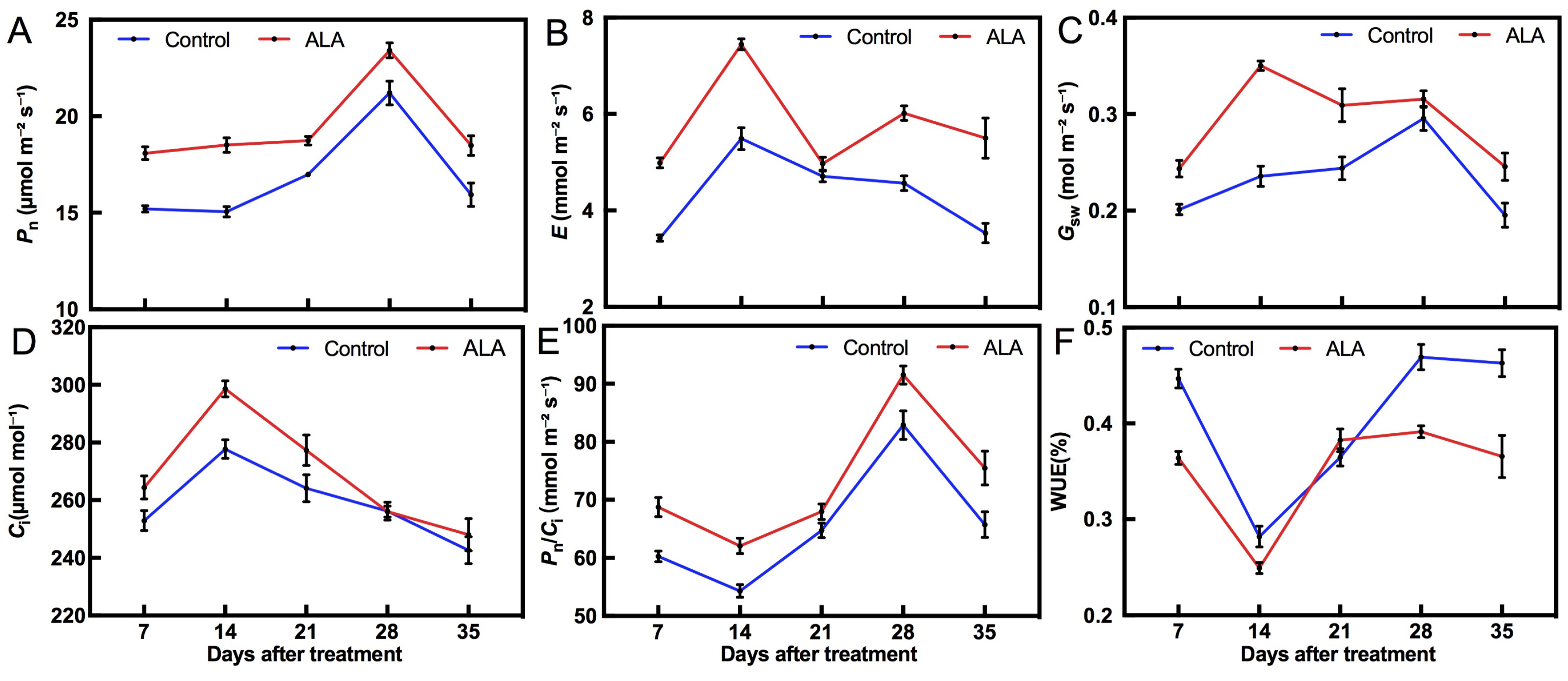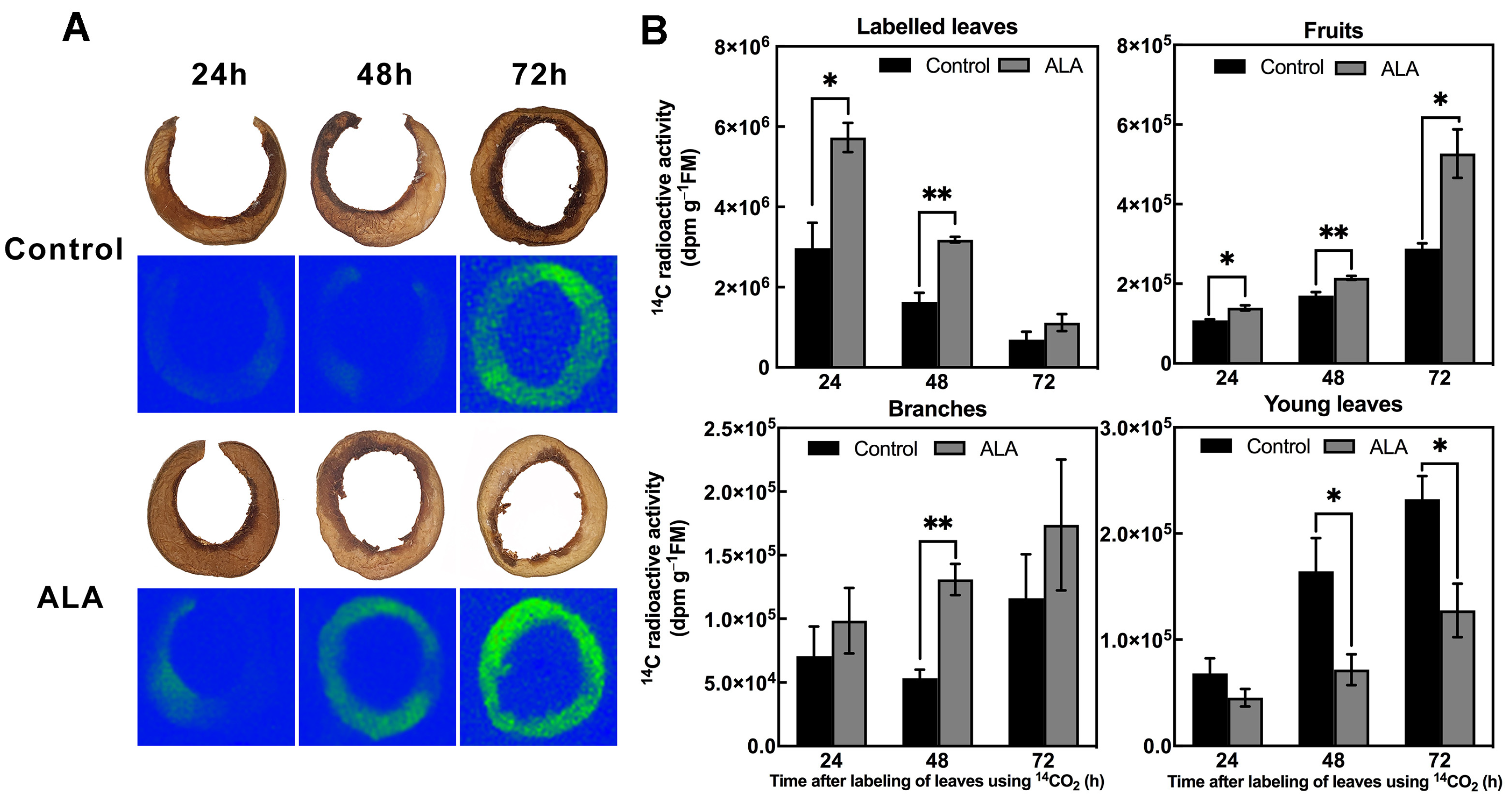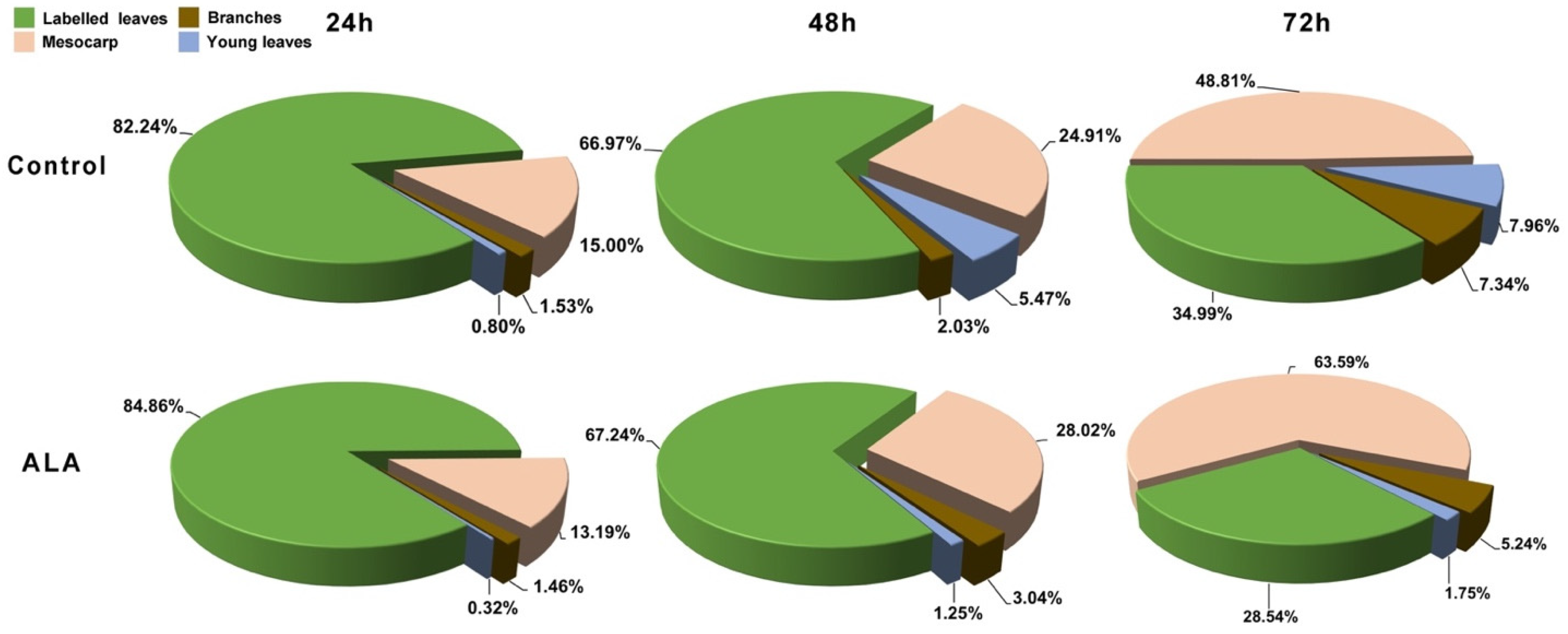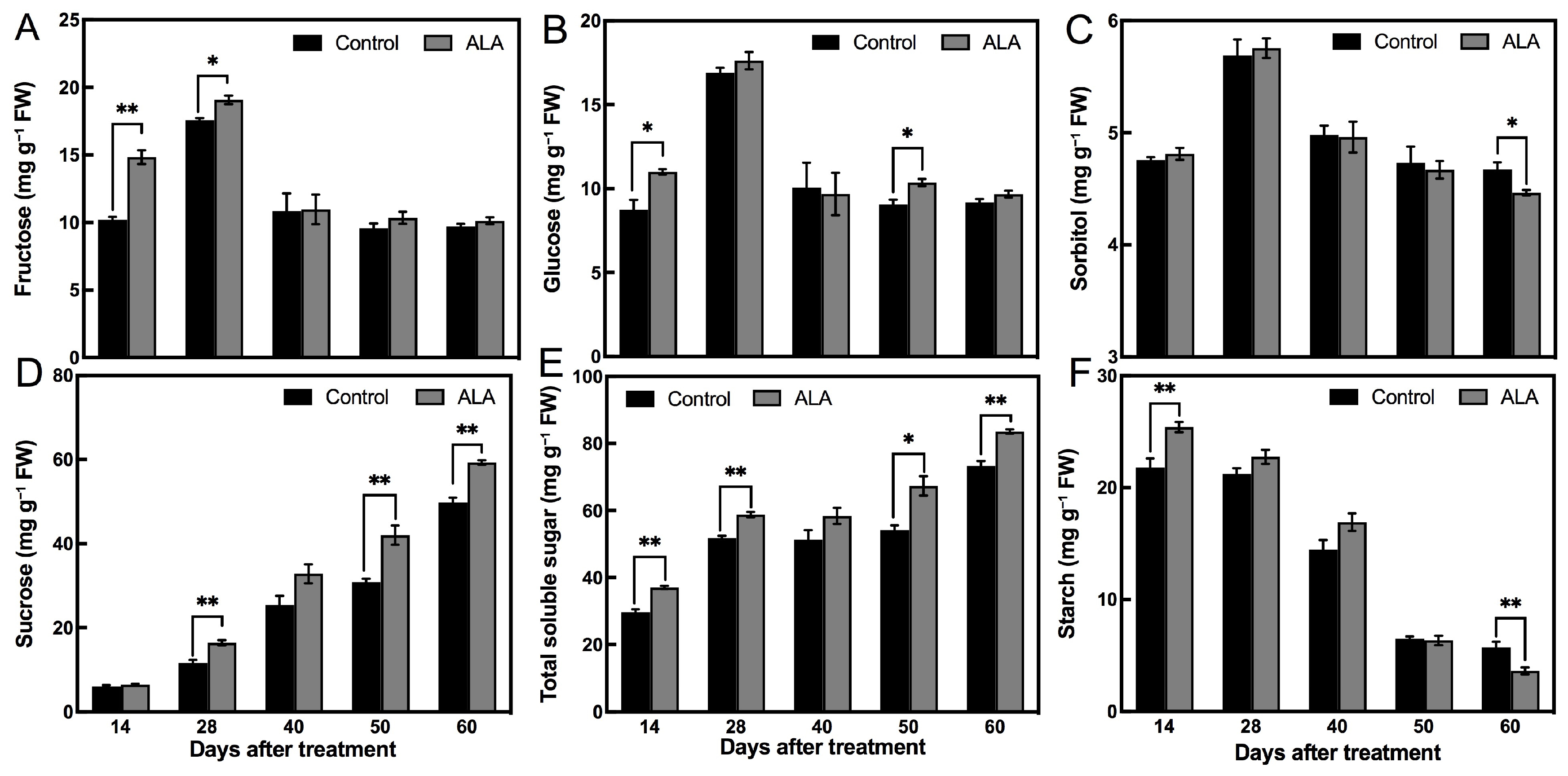Effects of Exogenous ALA on Leaf Photosynthesis, Photosynthate Transport, and Sugar Accumulation in Prunus persica L.
Abstract
:1. Introduction
2. Materials and Methods
2.1. Experimental Materials and Treatment
2.2. Analysis Methods
2.2.1. Determination of Photosynthetic Gas Exchange
2.2.2. Radiolabeling and Measurement of 14C
2.2.3. Radiographic Autoradiography of Fruit Slices
2.2.4. Extraction and Determination of Soluble Sugars and Starch
2.2.5. Determination of Sorbitol, Sucrose, Glucose, and Fructose
2.2.6. Extraction of Total RNA from Fruit and RT-qPCR Assay
2.3. Data and Statistical Analysis
3. Results
3.1. Effect of ALA Treatment on Leaf Gas Exchange of Nectarine in the Orchard
3.2. Effect of ALA Treatment on 14C-Assimilate Transport from Leaves to Peach Fruits
3.3. Effect of ALA Treatment on the Sugar Content in the Fruits during Nectarine Development
3.4. Effect of ALA Treatment on the Relative Expressions of the Sugar-Related Genes during Nectarine Development
3.5. Correlation Analysis between Expressions of the Sugar-Accumulation-Related Genes and the Sugar Content in Nectarine
4. Discussion
5. Conclusions
Author Contributions
Funding
Data Availability Statement
Acknowledgments
Conflicts of Interest
Appendix A
| Primer | Gene ID | Forward Primer (5′–3′) | Reverse Primer (5′–3′) |
|---|---|---|---|
| PpTEF | Prupe.4G138700 | gcacggatgggcttttac | aatagggcactgctggctgg |
| PpSUS1 | Prupe.7G192300 | agaggctgacatcattccac | gcttcgcattcttaccatacc |
| PpSUS2 | Prupe.1G483200 | agtggcacagaacacacaca | ccctgcaactcagcagctat |
| PpSUS3 | Prupe.8G264300 | gccatttatttcccttactctg | tgtaaccagcaaccacgac |
| PpSUS4 | Prupe.1G131700 | ttggagaaaacaaagcaccc | cccaggaagagtgaaagctgtgtgg |
| PpSUS5 | Prupe.3G014100 | cgttttgacatctatccctacc | caatagttgcctgagtaatccc |
| PpSUS6 | Prupe.5G241700 | taaggcggaaaacgatga | ttggatttggatgggtca |
| PpSUT1 | Prupe.8G052700 | ctgcttcttcctttccatca | cccatccaatcagtgtcg |
| PpSUT2 | Prupe.1G271500 | tcaacccggacacaaacaca | caatgtctgcagaaaacccga |
| PpSUT4 | Prupe.1G542000 | ctctgtttatggcggttgg | tcctgagctgctgatatgct |
| PpSPS1 | Prupe.7G249900 | tactggagcgtaaactgcg | tcttcatttgcttctgtctcac |
| PpSPS2 | Prupe.1G483200 | catggttgtaatacctcccg | gcaagtatcataggcttccgt |
| PpSPS3 | Prupe.1G159700 | gtctgcgttgccatcca | ttgccaccacccctttc |
| PpSPS4 | Prupe.8G003700 | atggcgggaaacgactg | agcacgtattctcaagcctatt |
| PpNI1 | Prupe.1G111800 | ttgaatgacaccaaggatgag | agaaagcgagtgccgatg |
| PpNI2 | Prupe.1G556900 | acattgatagcacctactcccc | ggctgcgaaagaagacca |
| PpCWINV | Prupe.3G009500 | cccaaaatcgccaagttca | gcttctcctgtttggttcgt |
| PpAI | Prupe.5G075600 | cttctatgttgccaaaggacc | ttgccttggttgggtaaat |
| PpSWEET1 | Prupe.6G355900 | gtgatggcggtcacactctt | acacagcacacatccatcca |
| PpSWEET2 | Prupe.1G220700 | tttccttacattgagtgccg | tcatcatcttctatgggtttgc |
| PpSWEET3 | Prupe.8G253500 | actatgccttcctcaagacca | caacactaatccacccaacaa |
| PpSWEET4 | Prupe.1G133300 | aatgttccttgctcctgtcg | tttgccctcatctttgctg |
| PpSWEET5 | Prupe.5G146500 | tctatgcccctaagaaagcc | gacaagacaaatccatcccac |
| PpSWEET6 | Prupe.3G283400 | ggtcggcattgtctgtgat | agcagcaaccatttaggaagt |
| PpSWEET7 | Prupe.8G076100 | taacgcaaagcgaaggatt | tcaagggtgaggcatacataa |
| PpSWEET8 | Prupe.3G034900 | gtctggaccatctatgcgct | caggatgatttgcaccgcac |
| PpSWEET9 | Prupe.5G125100 | caagaagcagaggctcaaag | caaacgatgcccacaataag |
| PpSWEET10 | Prupe.8G017400 | aggtcttctttggagttgttgg | aggaggcagttgagcattg |
| PpSWEET11 | Prupe.5G146400 | gttatccgaaccaagagcg | ccgaaggtgaatccaagtatg |
| PpSWEET12 | Prupe.4G155700 | ttctcagggctgccataca | atcccagcatcctcacctt |
| PpSWEET13 | Prupe.4G072300 | gtcaccactgccaacattca | acaacagcaactgccccta |
| PpSWEET14 | Prupe.2G118600 | ctcttaatgtagcctttccagc | ttagtgccaccacagttttca |
| PpSWEET15 | Prupe.5G175500 | atggagttgtctgggtggtc | ggtggcgtacaggatgagt |
| PpSWEET16 | Prupe.2G245600 | gttagcaccgttggatgga | tggcacaaattgtcaggga |
| PpSWEET17 | Prupe.2G307800 | gctagtcagcggaaatgcga | taccaagccgctgaaaggag |
| PpSS | Prupe.2G309400 | tgcacatcagggagtggaac | cacccattccagtgctccat |
| Ppα-GP | Prupe.3G257600 | atcctgaacacagcaggctc | gctgcttatttggggcaacc |
| PpGBSS | Prupe.5G132800 | tatggaacggtgcctattgt | catctgctgggtcaacttca |
| PpBAM1 | Prupe.3G221800 | tcccccagtgggtacttgat | ccactaaagagacgccggtt |
| PpBAM2 | Prupe.5G051000 | ctccgggcaaagagttcgat | gcaccttggaaccattgctg |
References
- Li, S.H. Peach Tree Science; China Agriculture Press: Beijing, China, 2013; pp. 1–10. [Google Scholar]
- Wang, L.R. Current situation and development suggestions of peach industry in China. China Fruits 2021, 10, 1–5. [Google Scholar]
- Lei, R.L.; Qu, W.G.; Fan, Y.J. Problems and countermeasures of nectarine industry development. Fruit Growers’ Friend 2016, 1, 38–39. [Google Scholar]
- Shu, H.R. Physiology of Fruit Tree Cultivation; China Agriculture Press: Beijing, China, 1993; pp. 38–42. [Google Scholar]
- Falchi, R.; Bonghi, C.; Drincovich, M.F.; Famiani, F.; Lara, M.V.; Walker, R.P.; Vizzotto, G. Sugar metabolism in stone fruit: Source-sink relationships and environmental and agronomical effects. Front. Plant Sci. 2020, 11, 573982. [Google Scholar] [CrossRef] [PubMed]
- Chen, J.W.; Zhang, L.C.; Zhang, S.L. Sugar accumulation mechanism in fruits. Plant Physiol. Commun. 2000, 36, 497–503. [Google Scholar]
- Liao, G.L.; Zhong, M.; Huang, C.H.; Jia, D.F.; Xu, X.B. Progress in research on sugar metabolism and related enzyme genes in fruit. Acta Agric. Univ. Jiangxi 2020, 42, 187–195. [Google Scholar]
- Li, J.M.; Li, D.X.; Feng, F.J.; Zhang, S.; Ma, F.W.; Cheng, L.L. Proteomic analysis reveals dynamic regulation of fruit development and sugar and acid accumulation in apple. J. Exp. Bot. 2016, 67, 5145–5157. [Google Scholar] [CrossRef] [PubMed] [Green Version]
- Li, J.M.; Huang, X.S.; Li, L.T.; Zheng, D.M.; Xue, C.; Zhang, S.L.; Wu, J. Proteome analysis of pear reveals key genes associated with fruit development and quality. Planta 2015, 241, 1346–1379. [Google Scholar] [CrossRef]
- Feng, L.J.; Wang, C.Z.; Yang, X.M.; Jiao, Q.Q.; Yin, Y.L. Transcriptomics and metabolomics analyses identified key genes associated with sugar and acid metabolism in sweet and sour pomegranate cultivars during the developmental period. Plant Physiol. Biochem. 2022, 181, 12–22. [Google Scholar] [CrossRef]
- Cui, B.; Liu, S.M.; Zheng, T. Chemotaxonomic identification of key taste and nutritional components in ‘Shushanggan Apricot’ fruits by widely targeted metabolomics. Molecules 2022, 27, 3870. [Google Scholar] [CrossRef]
- Benoit, B.; William, A.; Catherine, D.; Xu, Y.; Mickael, M.; Bertrand, B.; Warwick, B.D.; Daniel, J.; Royston, G.; Dominique, R.; et al. 1H NMR, GC–EI-TOFMS, and data set correlation for fruit metabolomics: Application to spatial metabolite analysis in melon. Anal. Chem. 2009, 81, 2884–2894. [Google Scholar]
- Marius, G.M.; Roxana, E.I.; Diana, C.; Oana, R.B. Classification of prunus genus by botanical origin and harvest year based on carbohydrates profile. Foods 2022, 11, 2838. [Google Scholar]
- Wang, L.J.; Jiang, W.B.; Zhang, Z.; Matsui, H.; Ohara, H. Biosynthesis and physiological activities of 5-aminolevulinic acid (ALA) and its potential application in agriculture. Plant Physiol. Commun. 2003, 39, 185–192. [Google Scholar]
- Wu, Y.; Liao, W.B.; Dawuda, M.M.; Hu, L.L.; Yu, J.H. 5-Aminolevulinic acid (ALA) biosynthetic and metabolic pathways and its role in higher plants: A review. Plant Growth Regul. 2019, 87, 357–374. [Google Scholar] [CrossRef] [Green Version]
- Gao, J.J.; Feng, X.X.; Duan, C.H.; Li, J.H.; Shi, Z.X.; Gao, F.Y.; Wang, L.J. Effects of 5-aminolevulinic acid (ALA) on leaf photosynthesis and fruit quality of apples. J. Fruit Sci. 2013, 30, 944–951. [Google Scholar]
- Xie, L.; Cheng, X.H.; Feng, X.X.; Yang, T.; Zhang, Z.P.; Wang, L.J. Effects of an amino acid fertilizer on the leaf photosynthesis and fruit quality of ‘Summer Black’ grape. J. Nanjing Agric. Univ. 2013, 36, 31–37. [Google Scholar]
- Wang, J.W.; Zhang, J.; Li, J.; Mohammed, M.D.; Basharat, A.; Wu, Y.; Yu, J.H.; Tang, Z.Q.; Lyu, J.; Xiao, X.M.; et al. Exogenous application of 5-aminolevulinic acid promotes coloration and improves the quality of tomato fruit by regulating carotenoid metabolism. Front. Plant Sci. 2021, 9, 683868. [Google Scholar] [CrossRef]
- Zheng, J.; Liu, L.B.; Tao, H.H.; An, Y.Y.; Wang, L.J. Transcriptomic profiling of apple Calli with a focus on the key genes for ALA-induced anthocyanin accumulation. Front. Plant Sci. 2021, 12, 640606. [Google Scholar] [CrossRef]
- Fang, X.; Zhang, L.Z.; Wang, L.J. The transcription factor MdERF78 is involved in ALA-induced anthocyanin accumulation in apples. Front. Plant Sci. 2022, 13, 915197. [Google Scholar] [CrossRef]
- Zhang, H.W.; Tao, H.H.; Yang, H.; Zhang, L.Z.; Fang, G.Z.; An, Y.Y.; Wang, L.J. MdSCL8 as a negative regulator participates in ala-induced FLS1 to promote flavonol accumulation in apples. Int. J. Mol. Sci. 2022, 23, 2033. [Google Scholar] [CrossRef]
- Wang, J.W.; Yuan, H.; Wu, Y.; Yu, J.H.; Basharat, A.; Zhang, J.; Tang, Z.Q.; Xie, J.M.; Lyu, J.; Liao, W.B. Application of 5-aminolevulinic acid promotes ripening and accumulation of primary and secondary metabolites in postharvest tomato fruit. Front. Nutr. 2022, 9, 1036843. [Google Scholar] [CrossRef]
- Ye, J.B.; Yang, X.H.; Chen, Q.W.; Xu, F.; Wang, G.Y. Promotive effects of 5-aminolevulinic acid on fruit quality and coloration of Prunus persica (L.) batsch. Sci. Hortic. 2017, 217, 266–275. [Google Scholar] [CrossRef]
- Wu, T. The Characteristics of Sugar Accumulation and Its Relationship with Fruit Size during the Fruit Development in ‘Hosui’ and ‘Yali’ Pars. Ph.D. Thesis, Nanjing Agricultural University, Nanjing, China, 2011. [Google Scholar]
- Li, W. Absorption, Translocation, Accumulation and Metabolism of 14C-Benzene Kresoxim-Methyl in the Cucumber (Cucumis sativus L.). Ph.D. Thesis, Zhejiang University, Hangzhou, China, 2021. [Google Scholar]
- Guo, X.F.; Li, S.H.; Liu, G.J.; Fu, Z.F.; Li, S.T. Seasonal changes in carbohydrate content and related enzyme activity in fruit and leaves of ‘Yanfengyihao’ peach variety. J. Fruit Sci. 2004, 21, 196–200. [Google Scholar]
- Li, H.S. Principles and Techniques of Plant Physiological and Biochemical Experiments; Higher Education Press: Beijing, China, 2000; pp. 195–197. [Google Scholar]
- Niu, J.; Zhao, J.B.; Wu, B.H.; Li, S.H.; Liu, G.J.; Jiang, Q. Sugar and acid contents in peach and nectarine derived from different countries and species. Acta Hortic. Sin. 2006, 33, 6–11. [Google Scholar]
- Ye, Z.W.; Li, X.W.; Ma, Y.P.; Su, M.S.; Zhou, J.Y.; Du, J.H. Research progress of sugar metabolism in peach. Acta Agric. Shanghai 2019, 35, 144–150. [Google Scholar]
- Wang, L.J.; Wang, Z.H.; Li, Z.Q.; Liu, H.; Liu, W.Q.; Chen, Z.Y.; Yan, P.; Sun, D.Q. Effect of 5-aminolevulinic acid on enhancing apple fruit coloraion. J. Fruit Sci. 2004, 21, 512–515. [Google Scholar]
- Wang, Z.H.; Tang, G.H.; Li, Z.Q.; Wang, L.J. Promotion of 5-aminolevulinic acid and genistein on anthocyanin accumulation in apples. Acta Hortic. Sin. 2006, 33, 1055–1058. [Google Scholar]
- Feng, X.X.; An, Y.Y.; Zheng, J.; Sun, M.; Wang, L.J. Proteomics and SSH analyses of ALA-promoted fruit coloration and evidence for the involvement of a MADS-Box gene, MdMADS1. Front. Plant Sci. 2016, 7, 01615. [Google Scholar] [CrossRef] [Green Version]
- Guo, L.; Cai, Z.X.; Zhang, B.B.; Xu, J.L.; Song, H.F. The mechanism analysis of anthocyanin accumulation in peach accelerated by ALA. Acta Hortic. Sin. 2013, 40, 1043–1050. [Google Scholar]
- Guo, L.; Zhang, B.B.; Ma, R.J.; Song, H.F.; Cai, Z.X. Effect of 5-aminolevulinic acid treatment on fruit quality and nutritional growth of peach. Jiangsu Agric. Sci. 2015, 43, 194–196. [Google Scholar]
- Zhang, L.Y.; Feng, X.X.; Gao, J.J.; An, Y.Y.; Tian, F.; Li, J.; Zhang, Z.P.; Wang, L.J. 2015. Effects of rhizosphere-applied 5-aminolevulinic acid (ALA) solutions on leaf physiological characteristics and fruit quality of apples. Jiangsu J. Agric. Sci. 2015, 31, 158–165. [Google Scholar]
- Watanabe, K.; Nishihara, E.; Watanabe, S.; Tanaka, T.; Takahashi, K.; Takeuchi, Y. Enhancement of growth and fruit maturity in 2-year-old grapevines cv. Delaware by 5-aminolevulinic acid. Plant Growth Regul. 2006, 49, 35–42. [Google Scholar] [CrossRef]
- Akram, N.A.; Ashraf, M. Regulation in plant stress tolerance by a potential plant growth regulator, 5-aminolevulinic acid. J. Plant Growth Regul. 2013, 32, 663–679. [Google Scholar] [CrossRef]
- Wang, L.J.; Shi, W.; Liu, H.; Liu, W.Q.; Jiang, W.B.; Hou, X.L. Effects of exogenous 5-aminolevulinic acid treatment on leaf photosynthesis of pak-choi. J. Nanjing Agric. Univ. 2004, 27, 34–38. [Google Scholar]
- Wu, W.W.; He, S.S.; An, Y.Y.; Cao, R.X.; Sun, Y.P.; Tang, Q.; Wang, L.J. Hydrogen peroxide as a mediator of 5-aminolevulinic acid-induced Na+ retention in roots for improving salt tolerance of strawberries. Physiol. Plant. 2019, 167, 5–20. [Google Scholar] [CrossRef] [Green Version]
- Cai, C.Y.; He, S.S.; An, Y.Y.; Wang, L.J. Exogenous 5-aminolevulinic acid improves strawberry tolerance to osmotic stress and its possible mechanisms. Physiol. Plant. 2020, 168, 948–962. [Google Scholar] [CrossRef] [Green Version]
- Zhang, J.T.; Wei, X.; Zhang, H.W.; Liang, R.L.; An, Y.Y.; Wang, L.J. Mitigative effect of 5-aminolevulinic acid pretreatment on chilling injury of young leaves in peach. J. Fruit Sci. 2022, 39, 1407–1421. [Google Scholar]
- Liu, Y.m.; Ai, X.Z.; Yu, X.C. Effects of ALA on photosynthesis of cucumber seedlings under suboptimal temperature and light intensity. Acta Hortic. Sin. 2010, 37, 65–71. [Google Scholar]
- Chen, L.H.; Liu, L.B.; An, Y.Y.; Zhang, Z.P.; Wang, L.J. Preliminary studies on the possible mechanism underlying 5-aminolevulinic acid-induced stomatal opening in apple leaves. Acta Hortic. Sin. 2014, 41, 1965–1974. [Google Scholar]
- Yao, S.M.; Wang, W.J.; Chen, G.X. Effects of 5-aminolevulinic acid on phosphate absorption and distribution in rice using 32P tracer method. J. Plant Nutri. Fertil. 2006, 12, 70–75. [Google Scholar]
- Fan, S.; Gao, D.S.; Zhao, H.L. Characteristics of translocation and distribution of 14C-assimilates in peach fruit development under protected culture. J. Nucl. Agric. Sci. 2006, 20, 241–244+240. [Google Scholar]
- Fan, S.; Gao, D.S.; Han, H.X. Studies on the characteristics of distribution of 14C-assimilates in peach under protected culture. Acta Hortic. Sin. 2006, 35, 1067–1070. [Google Scholar]
- Wang, Z.Q.; Liu, S.E.; Niu, L.; Zong, X.P.; Song, Y.H. ‘Zhongyoutao 4’—A new early nectarine variety. Acta Hortic. Sin. 2003, 30, 631. [Google Scholar]
- Tian, Y.; Yao, G.X. Development status, problems and countermeasures of protected fruit tree industry in Jiangsu Province. China Fruits 2022, 221, 98–102. [Google Scholar]
- Wang, Y.Q.; Wu, B.H.; Zhao, J.B.; Jiang, Q.; Li, S.H. Soluble sugar contents in fruits and leaves during fruit development and their relationship in peach cultivars of difference in fruit glucose/fructose. Sci. Agric. Sin. 2008, 41, 2063–2069. [Google Scholar]
- Zhang, C.H.; Yu, M.L.; Ma, R.J.; Zhang, B.B.; Shen, Z.J. Dynamic changes of carbohydrate content and expression level of sucrose synthase genes in peach (Prunus persica) at different developmental stages. Jiangsu J. Agric. Sci. 2014, 30, 1456–1463. [Google Scholar]
- Wang, Y.X. Effects of “Jincunqiu” Foliar Fertilizer Treatment on Fruit Development and Quality of ‘Zhongyou 4’ Nectarine. Master’s Thesis, Nanjing Agricultural University, Nanjing, China, 2022. [Google Scholar]
- Zhang, C.H.; Shen, Z.J.; Zhang, Y.P.; Han, J.; Ma, R.J.; Korir, N.K.; Yu, M.L. Cloning and expression of genes related to the sucrose-metabolizing enzymes and carbohydrate changes in peach. Acta Physiol. Plant. 2013, 35, 589–602. [Google Scholar] [CrossRef]
- Muhammad, M.A.; Li, D.; Wang, X.B.; Wang, Y.; Pan, L.; Liu, H.; Niu, L.; Lu, Z.H.; Cui, G.C.; Zeng, W.F.; et al. Expression patterns of genes involved in sugar metabolism and accumulation during peach fruit development and ripening. Sci. Hortic. 2019, 257, 108633. [Google Scholar]
- Moriguchi, T.; Sananda, T.; Yamaki, S. Seasonal fluctuations of some enzymes relating to sucrose and sorbitol metabolism in peach fruit. J. Amer. Soc. Hort. Sci. 1990, 115, 278–281. [Google Scholar] [CrossRef] [Green Version]
- Moriguchi, T.; Yamaki, S. Purification and characterization of sucrose synthase from Peach (Prunus persica) Fruit. Plant Cell Physiol. 1988, 29, 1361–1366. [Google Scholar]
- Zhang, C.H.; Yu, M.L.; Ma, R.J.; Shen, Z.J.; Zhang, B.B.; Korir, N.K. Structure, expression profile, and evolution of the sucrose synthase gene family in peach (Prunus persica). Acta Physiol. Plant. 2015, 37, 81. [Google Scholar] [CrossRef]
- Kuhn, C.; Grof, C.P.L. Sucrose transporters of higher plants. Curr. Opin. Plant Biol. 2010, 13, 288–298. [Google Scholar] [CrossRef] [PubMed]
- Zanon, L.; Falchi, R.; Hackel, A.; Kuhn, C.; Vizzotto, G. Expression of peach sucrose transporters in heterologous systems points out their different physiological role. Plant Sci. 2015, 238, 262–272. [Google Scholar] [CrossRef] [PubMed]
- Wei, X.N. Functional Identification of Sucrose Transporters and Protein Expression Analysis of PpSUT2 from Peach. Master’s Thesis, Henan Agricultural University, Zhengzhou, China, 2016. [Google Scholar]
- Wang, Q.H. Cloning and Expression Analysis of Sucrose Transporters in Peach (Prunus persica (L.) Batsch). Master’s Thesis, Henan Agricultural University, Zhengzhou, China, 2015. [Google Scholar]
- Geng, Y.Q.; Dong, X.C.; Zhang, C.M. Recent progress of sugar transporter in horticultural crops. Acta Hortic. Sin. 2021, 48, 676–688. [Google Scholar]
- Yuan, M.; Wang, S.P. Rice MtN3/saliva/SWEET family genes and their homologs in cellular organisms. Mol. Plant. 2013, 6, 665–674. [Google Scholar] [CrossRef] [Green Version]
- Huang, C.; Li, X.N.; Li, S.Y.; Wang, J.D. Research progress of plant SWEET gene family. Chin. Agric. Sci. Bull. 2022, 38, 17–26. [Google Scholar]
- Zhen, Q.L.; Fang, T.; Peng, Q.; Liao, L.; Zhao, L.; Owiti, A.; Han, Y.P. Developing gene-tagged molecular markers for evaluation of genetic association of apple SWEET genes with fruit sugar accumulation. Hortic. Res. 2018, 5, 14. [Google Scholar] [CrossRef] [Green Version]
- Lu, J.; Ma, Q.J.; Kang, H.; Li, W.H.; Liu, Y.J.; Hao, Y.J.; You, C.X. Ectopic expressing MdSWEET1 in tomato enhanced salt tolerance. Acta Hortic. Sin. 2019, 46, 433–443. [Google Scholar]
- Zheng, Q.M.; Tang, Z.; Xu, Q.; Deng, X.X. Isolation, phylogenetic relationship and expression profiling of sugar transporter genes in sweet orange (Citrus sinensis). Plant Cell Tiss. Organ Cult. 2014, 119, 609–624. [Google Scholar] [CrossRef]
- Li, J.M. Identification of Pear Sugar Transporter Genes and PbtMT4 and PbSWEET Genes Function Analysis. Ph.D. Thesis, Nanjing Agricultural University, Nanjing, China, 2017. [Google Scholar]
- Eloïse, M.; Sylvain, L.C.; Mary-lorène, G.; Hélène, L.; Pere, M.; Julie, C. Overexpression of the VvSWEET4 transporter in grapevine hairy roots increases sugar transport and contents and enhances resistance to Pythium irregulare, a soilborne pathogen. Front. Plant Sci. 2019, 10, 884. [Google Scholar]
- Zhang, L. The Regulation and Mechanism of Low Temperature and Peach-Gum Coating on Postharvest Peach Ripening and Senescence. Ph.D. Thesis, Huazhong Agricultural University, Wuhan, China, 2020. [Google Scholar]
- Jia, M.X. Identification of Members of SWEET Gene Family of Peach and Their Function in Sucrose Transport. Master’s Thesis, Southwest University, Chongqing, China, 2021. [Google Scholar]






Disclaimer/Publisher’s Note: The statements, opinions and data contained in all publications are solely those of the individual author(s) and contributor(s) and not of MDPI and/or the editor(s). MDPI and/or the editor(s) disclaim responsibility for any injury to people or property resulting from any ideas, methods, instructions or products referred to in the content. |
© 2023 by the authors. Licensee MDPI, Basel, Switzerland. This article is an open access article distributed under the terms and conditions of the Creative Commons Attribution (CC BY) license (https://creativecommons.org/licenses/by/4.0/).
Share and Cite
Liang, R.; Wang, L.; Wang, X.; Zhang, J.; Gan, X. Effects of Exogenous ALA on Leaf Photosynthesis, Photosynthate Transport, and Sugar Accumulation in Prunus persica L. Forests 2023, 14, 723. https://doi.org/10.3390/f14040723
Liang R, Wang L, Wang X, Zhang J, Gan X. Effects of Exogenous ALA on Leaf Photosynthesis, Photosynthate Transport, and Sugar Accumulation in Prunus persica L. Forests. 2023; 14(4):723. https://doi.org/10.3390/f14040723
Chicago/Turabian StyleLiang, Ruolin, Liangju Wang, Xinqing Wang, Jianting Zhang, and Xing Gan. 2023. "Effects of Exogenous ALA on Leaf Photosynthesis, Photosynthate Transport, and Sugar Accumulation in Prunus persica L." Forests 14, no. 4: 723. https://doi.org/10.3390/f14040723
APA StyleLiang, R., Wang, L., Wang, X., Zhang, J., & Gan, X. (2023). Effects of Exogenous ALA on Leaf Photosynthesis, Photosynthate Transport, and Sugar Accumulation in Prunus persica L. Forests, 14(4), 723. https://doi.org/10.3390/f14040723







